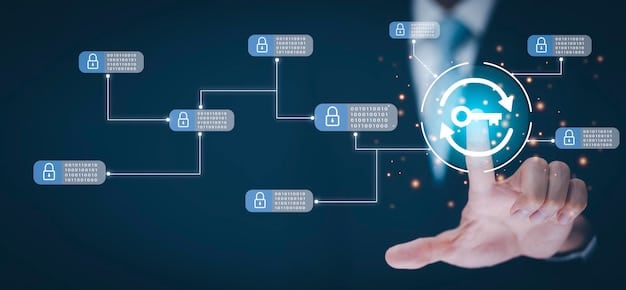Fraud Prevention 2025: AI-Powered E-commerce Payment Security

In 2025, US e-commerce stores must prioritize AI-powered payment security to combat evolving fraud, leveraging machine learning for real-time detection, behavioral biometrics, and enhanced data encryption to protect transactions and customer trust.
As we approach 2025, the landscape of e-commerce is rapidly evolving, bringing both unprecedented opportunities and escalating challenges. Among these challenges, payment fraud stands out as a significant threat to US e-commerce stores. To combat this, implementing **Fraud Prevention in 2025: Implementing AI-Powered Payment Security for Your US E-commerce Store** becomes not just an option but a necessity.
The Escalating Threat of E-commerce Fraud
E-commerce fraud is on the rise and poses a significant danger to US e-commerce companies. Understanding the numerous fraud types and their financial ramifications is critical for business protection.
Understanding the Different Types of E-commerce Fraud
E-commerce fraud encompasses a wide range of malicious activities, each with its own set of characteristics and potential consequences. Recognizing these different types is the first step in developing effective prevention strategies.
- Card-Not-Present (CNP) Fraud: This occurs when a credit card is used without the physical card being present, typically in online transactions.
- Account Takeover (ATO): Fraudsters gain unauthorized access to a customer’s account and use it to make fraudulent purchases.
- Triangulation Fraud: Scammers set up fake online stores to collect credit card information, then use it for unauthorized purchases.
- Refund Fraud: Customers make legitimate purchases but then falsely claim they never received the item or that it was defective to get a refund.
The financial impact of these frauds can be devastating, leading to lost revenue, chargeback fees, and damage to a company’s reputation. Implementing robust fraud prevention measures is essential to mitigate these risks.
Ultimately, the escalating threat of e-commerce fraud necessitates a proactive approach, combining advanced technological solutions with comprehensive security protocols to safeguard online businesses and their customers.
The Role of AI in Payment Security
Artificial intelligence (AI) is revolutionizing payment security by offering superior detection, prevention, and response capabilities. Machine learning algorithms can analyze vast amounts of data to identify potentially fraudulent transactions in real-time.
How AI Enhances Fraud Detection
AI excels at detecting fraudulent activity by identifying patterns and anomalies that would be impossible for humans to spot. Here’s how AI enhances fraud detection:
- Real-Time Analysis: AI algorithms analyze transactions as they occur, flagging suspicious activity instantly.
- Behavioral Analysis: AI can identify unusual purchasing patterns by analyzing a customer’s historical data.
- Machine Learning: AI systems learn from past fraud cases, improving their accuracy and effectiveness over time.

The use of AI in payment security not only reduces fraud rates but also enhances the overall customer experience by minimizing false positives and ensuring legitimate transactions are processed smoothly.
In conclusion, AI’s ability to process and analyze vast amounts of data in real-time makes it an indispensable tool for modern payment security, providing a proactive defense against evolving fraud threats.
Key AI Technologies for Fraud Prevention
Several AI technologies play critical roles in modern fraud prevention. Machine learning, behavioral biometrics, and natural language processing are among the most effective.
Exploring Machine Learning, Behavioral Biometrics, and NLP
Each AI technology brings unique capabilities to the fight against fraud:
- Machine Learning: Utilizes algorithms that learn from data to identify patterns and predict future fraud attempts.
- Behavioral Biometrics: Analyzes a user’s behavior, such as typing speed and mouse movements, to verify their identity.
- Natural Language Processing (NLP): Examines text-based data, such as customer reviews and emails, to detect scams and phishing attempts.
These technologies work together to create a comprehensive fraud prevention system that adapts to new threats and protects payment systems from a variety of attacks.
In summary, machine learning, behavioral biometrics, and NLP are powerful AI technologies that can significantly enhance fraud prevention efforts by providing advanced detection and authentication capabilities.
Implementing AI in Your E-commerce Store
Integrating AI-powered payment security into your e-commerce store requires careful planning and execution. Assessing your current security infrastructure and selecting the right AI solutions are crucial steps.

Steps to Integrate AI-Powered Payment Security
Here are the key steps to successfully integrate AI into your e-commerce security framework:
- Assess Your Current Security Infrastructure: Identify vulnerabilities and areas that need improvement.
- Choose the Right AI Solutions: Select AI tools that align with your specific business needs and risk profile.
- Integrate AI Systems: Implement the AI solutions into your existing payment processing systems.
- Monitor and Optimize: Continuously monitor the performance of AI systems and make adjustments as needed.
By following these steps, e-commerce stores can seamlessly integrate AI-powered payment security, improving fraud detection accuracy and efficiency.
All things considered, by taking a methodical approach to integrating AI into your e-commerce platform, you can dramatically improve your resilience against fraud and create a more reliable environment for your customers.
Challenges and Considerations
While AI provides significant advantages in fraud prevention, several challenges and considerations must be addressed. Data privacy, bias in algorithms, and the need for continuous monitoring are key issues.
Addressing Data Privacy, Bias, and Monitoring
Navigating the complexities of AI implementation requires careful attention to the following aspects:
- Data Privacy: Ensuring compliance with data protection regulations, such as GDPR and CCPA, is essential.
- Bias in Algorithms: Mitigating bias in AI algorithms to ensure fair and accurate fraud detection.
- Continuous Monitoring: Regularly monitoring AI systems to detect and address performance issues and emerging threats.
Addressing these challenges will help e-commerce stores maximize the benefits of AI while maintaining ethical and legal standards.
In closing, effectively dealing with these issues ensures that AI technologies not only improve security standards but also support ethical business practices.
Future Trends in AI and Payment Security
The future of payment security will be shaped by ongoing advancements in AI. Quantum computing, enhanced behavioral biometrics, and decentralized identity solutions are likely to play significant roles.
The Evolution of AI in Fraud Prevention
Looking ahead, the following trends will influence the development of AI-powered payment security:
- Quantum Computing: Quantum computing could revolutionize fraud detection by providing unprecedented processing power.
- Enhanced Behavioral Biometrics: Advanced biometric techniques will improve identity verification accuracy.
- Decentralized Identity Solutions: Blockchain-based identity systems will enhance security and privacy.
Staying informed about these trends will help e-commerce stores prepare for the future of payment security and remain ahead of emerging threats.
As can be seen, by following these trends and advances, e-commerce businesses may anticipate and adjust to the ever-changing environment of payment security, providing their customers with cutting-edge protection.
| Key Aspect | Brief Description |
|---|---|
| 🛡️ AI Detection | Real-time analysis to flag suspicious transactions instantly. |
| 🔑 Behavioral Analysis | Identifying unusual purchasing patterns using historical data. |
| 🤖 Machine Learning | Improving accuracy through learning from past instances of fraud. |
| 🔒 Data Privacy | Ensuring compliance with GDPR, CCPA, and other regulations. |
Frequently Asked Questions
▼
AI-powered payment security uses artificial intelligence to detect and prevent fraudulent transactions in real-time, enhancing protection for e-commerce businesses and customers.
▼
Machine learning algorithms learn from vast amounts of data to identify patterns of fraud, improving the accuracy and efficiency of fraud detection.
▼
Behavioral biometrics analyzes a user’s unique behavior, such as typing speed and mouse movements, to verify their identity and prevent unauthorized account access.
▼
Data privacy is crucial to ensure that AI systems comply with regulations like GDPR and CCPA, protecting customer data and maintaining legal and ethical standards.
▼
Future trends include quantum computing for enhanced processing power, advanced behavioral biometrics for better identity verification, and decentralized identity solutions for increased security and privacy.
Conclusion
Implementing AI-powered payment security is pivotal for US e-commerce stores in 2025. By leveraging AI technologies, addressing data privacy concerns, and staying informed about future trends, businesses can protect themselves and their customers from evolving fraud threats, fostering a secure and trustworthy online environment.





